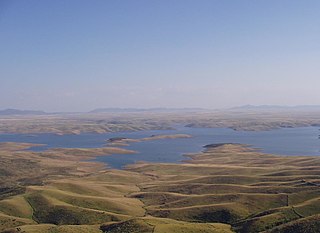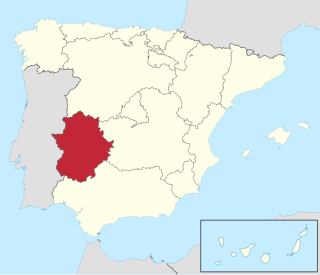
Extremadura is a landlocked autonomous community of Spain. Its capital city is Mérida, and its largest city is Badajoz. Located in the central-western part of the Iberian Peninsula, it is crossed from east to west by the Tagus and Guadiana rivers. The autonomous community is formed by the two largest provinces of Spain: Cáceres and Badajoz. Extremadura is bordered by Portugal to the west and by the autonomous communities of Castile and León (north), Castilla–La Mancha (east) and Andalusia (south).

The province of Badajoz is a province of western Spain located in the autonomous community of Extremadura. It was formed in 1833. It is bordered by the provinces of Cáceres in the north, Toledo, Ciudad Real in the east, Córdoba in the south-east, Seville, and Huelva in the south and Portugal in the west.

In Spain, a comarca is either a traditional territorial division without any formal basis, or a group of municipalities, legally defined by an autonomous community for the purpose of providing common local government services. In English, a comarca is equivalent to a district, county, area or zone.
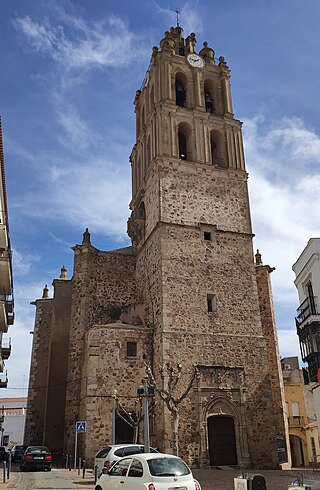
Almendralejo is a town in the Province of Badajoz, Extremadura, Spain. It is situated 45 km south-east of Badajoz, on the main road and rail route between Mérida and Seville. As of 2010, it has a population of 33,975. It was the site of a battle and massacre in 1936 during the Spanish Civil War.
Milagros is a Spanish village and municipality in the province of Burgos, part of the autonomous community of Castile and León. It has a population of approximately 502 people and is 10 km from Aranda de Duero. Milagros is in the comarca and wine region of the Ribera del Duero.

The Ribera del Duero is a comarca or district located at the southern tip of the province of Burgos, part of the Spanish autonomous community of Castile and León. The capital of the Ribera del Duero comarca or district is the town of Aranda de Duero.
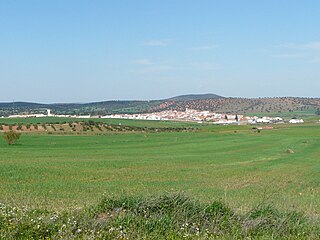
Retamal de Llerena is a municipality located in the province of Badajoz, Extremadura, Spain. According to the 2008 census (INE), it has a population of 497 people.

Curiel de Duero is a municipality located in the province of Valladolid, Castile and León, Spain. It covers an area of 18,75 km2, has a population of 134 inhabitants, yielding a density of 6,93 inhabitants/km2. It belongs to the Valle del Cuco and the county of Campo de Peñafiel. The municipalities of San Llorente, Corrales de Duero, Valdearcos de la Vega, and Bocos de Duero also belong to the Valle del Cuco. Roturas, that borders north to Curiel De Duero, historically also belonged to Curiel, but has in modern times not been included into the Valle del Cuco county. In 1900, Curiel had its peak of 590 inhabitants.

Sierra Suroeste is a comarca located in southwestern province of Badajoz in the autonomous community of Extremadura, western Spain. Its capital and largest city is Jerez de los Caballeros.

Tierra de Badajoz is a comarca in the province of Badajoz in the autonomous community of Extremadura, western Spain. The majority of its population, amounting to around 177,000 inhabitants, lives in the capital, the municipality of Badajoz, and the immediate surrounding area.
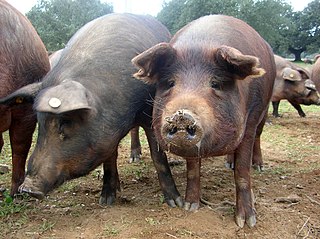
Extremadura, Spain is known for its different ways of preparing the Iberian pork and mutton. The main characteristics of the traditional Extremaduran cuisine are its simplicity, its lack of clutter and its low cost. It is also a cuisine reflecting a generous spirit, for many of its preparations used to be cooked in large pots to share with visitors, friends, and neighbors. The resulting dishes are eaten with local bread.

Campiña Sur is an administrative division (comarca) in the province of Badajoz, Extremadura, Spain. Its capital and administrative center is the municipality of Llerena. It contains 21 municipalities and 32,841 inhabitants in an area of 2,798 square kilometres (1,080 sq mi).

Las Vegas Altas, also known as Vegas Altas del Guadiana, is a comarca in the province of Badajoz, Extremadura, Spain. Its capital and administrative center is the urban area of the municipalities of Don Benito and Villanueva de la Serena. The comarca contains 16 municipalities and 90,697 inhabitants.
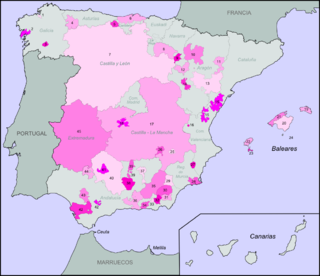
Vino de la tierra is a quality of Spanish wine that designates the rung below the mainstream quality wine classification of denominación de origen protegida (DOP). It is the equivalent of the French vin de pays. It represents a higher quality than table wine, and covers still wine, sparkling wine, and fortified wine. Since 2016 the classification is called indicación geográfica protegida (IGP), but wines can still use the traditional name of vino de la tierra. The labels of vino de la tierra wines are allowed to state the year of vintage and the grape varieties used in production.
Beba is a white Spanish grape variety grown for both wine and table grapes in the province of Extremadura. It is a vigorous, high-yielding vine that is sensitive to low temperatures and dampness during bloom. Annual productivity varies greatly depending on prevailing weather influences. It is grown for both wine and table grapes. It is also known as: Beba de los Santos, Beba de los Santos de Maimona, Beba de Palos, Beba Dorada, Beba Dorada de Huelva, Beba Dorada de Jaen, Beba Dorada de Jerez, Beva, Bevah, Bevan, Eva de los Santos, Eva de los Santos de Maimona, and White Malaga. This was the vine presented by Louis XIV's ambassador to King Narai of Siam, where it became the start of a flourishing grape industry.

Tierra de Mérida - Vegas Bajas is a comarca in the province of Badajoz, Extremadura, Spain. It contains the following municipalities:
3 Riberas is a Spanish geographical indication for Vino de la Tierra wines located in the autonomous region of Navarre. Vino de la Tierra is one step below the mainstream Denominación de Origen indication on the Spanish wine quality ladder, and mirrors the Vins de pays of French wine. It acquired its Vino de la Tierra status in 2018.











